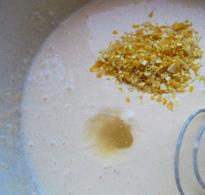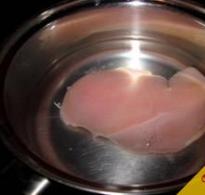What happens if you eat raw meat?! Symptoms of rotten chicken poisoning.
Raw meat dishes can be found in many national world cuisines. At the same time, they are considered tasty, healthy and very refined: real gourmets say that raw meat has a more pleasant taste and delicate aroma than meat dishes that have undergone any heat treatment.
Different nations have their preferences. Most often raw beef is eaten, but there are also dishes from venison, lamb and even poultry. In the first positions in the popularity rating of raw meat dishes are carpaccio and tartare. Carpaccio are very thin slices of beef marinated in a mixture of vinegar, lemon juice and oil. And tartare, popular in many countries, is a ball of raw chopped minced meat with a lot of spices, inside of which is a raw egg yolk.
This dish is sometimes called tatar steak. There is a legend that the prototype of tartare was pieces of meat that the warriors of the Tatar-Mongol yoke carried under the saddles of their horses and ate raw, because they simply did not have time to fry due to constant movements. This meat was saturated with horse sweat, became salty and slightly dried.
And in the Arctic, stroganina is very popular - shavings from raw frozen meat. Raw meat lovers are everywhere, not without reason in many restaurants one of the obligatory items on the menu is a steak with blood.
Of course, tastes differ, but it's not just about taste. It is worth thinking about whether it is possible to eat raw meat? Do lovers of such culinary delights risk their health?
Yes, in any raw product, including meat, there are much more vitamins, trace elements and other useful substances than in the one that was boiled, baked or fried. However, not all products can be safely eaten without prior heat treatment, especially products of animal origin. So why not eat raw meat?
An adult bull tapeworm reaches 4-40 meters in length. The life span of bovine tapeworm in the human intestine, if no deworming measures are taken, is 18-20 years. A tapeworm produces ~ 600 million eggs per year, ~ 11 billion in a lifetime.
If you cannot deny yourself this pleasure, then at least watch the quality of the original product very carefully. Eating raw meat bought in a store or market is dangerous and very frivolous. You can cook the same tartare or carpaccio only from the meat of a guaranteed healthy animal, slaughtered in compliance with sanitary standards. And you can know for sure only if you trust the farmer or private trader from whom you buy meat. However, there is a certain risk here as well. In some farms, animals are kept in unsuitable conditions, antibiotics and substances are added to their feed to accelerate growth. Therefore, think carefully before eating raw meat and dishes from it.
Residents of the Far North do not even wonder if it is possible to eat raw meat, since for them stroganina from frozen venison, cod is the most common and very favorite product.
Juicy steak, dripping with pinkish juice, from only lightly fried beef, rolls and sushi with raw fish ... What can I say?! Herring is also actually raw meat! We eat it without thinking about the consequences. Can it be harmful to health?
What raw meat can you eat
Why, despite all the dangers of raw meat, can you eat it?
Beef, venison and other goat meat are also not allowed, but eating you is unlikely to kill you right away. If you agree to tolerate a neighbor in the intestines, then we will try to at least reduce the risk of such a food experiment.
Ways to eat raw meat
Let's get straight to the point:
- Raw chicken meat, like the meat of other birds, is not eaten. Salmonellosis is practically guaranteed, and freezing does not help.
- The meat of nutria, rabbits is not eaten raw, as it is tasteless.
- Game, any forest bear meat, elk, poultry are not eaten raw. Infection with various worms in the wild is equal to 100%.
- Pork is not eaten raw, as this meat is also almost always infected.
- Goat meat, horse meat and sheep meat are not eaten raw, as they are tough and disgusting in taste without processing.
- salted fish;
- frozen fish, especially tasty stroganina, marinated meat of red fish and fatty varieties of sea;
- beef and veal after a short heat treatment are eaten only if it has a sanitary and epidemic conclusion, but even in this case you take risks;
- you can eat raw deer meat grown artificially; it must have a sanitary-epidemiological conclusion.
One more thing to help you think. When humans discovered fire and cooked food appeared, humanity changed forever. Anthropologists have discovered that just when we began to fry meat, and not eat it raw, the development of the brain accelerated, speech appeared, complex tools appeared, and we became people. Why degrade?
How you can save on cooking and electricity (or whatever your stove runs on). To do this, you need a piece of fresh meat, a sharp knife and a pair of clean hands. Why is eating raw beef even healthy?EAT RAW MEAT IN A DREAM
- to some kind of trouble, the dream books say. Absorbing it thoughtlessly in reality - to such troubles that you never dreamed of. So that you understand: meat is boiled (fried, steamed) not at all so that it is better digested. And in order to destroy pathogenic bacteria that have penetrated into it, worm larvae and various infections.What can't be eaten
You definitely shouldn't put raw pork in your mouth, because pigs are omnivores. During life, the animal ate something wrong, and now you have pork tapeworm or trichinella in your plate. The concentration of tapeworm larvae in pork is uneven, so even from veterinary control they can escape.The ram seems to be clean and nibbles on grass, but its meat is too tough and simply tasteless when raw.
What can you eat
We have a rather meager choice - you can only eat raw beef, since cows eat plant foods and are less likely to carry any infection. Fresh meat from a freshly slaughtered bull is good, but harsh. Chilled, aged beef from the store is also good and even softer (take the tenderloin, it is the most tender). The best option is meat that has undergone shock freezing (at temperatures up to -40 ° C). Harmful bacteria will definitely be destroyed, and the structure of the meat will not suffer, as is the case with conventional freezing. Just remember to defrost it before eating.What is the use
Beef contains a lot of iron, phosphorus and B vitamins, which activate the fat burning process in the body. It also contains zinc, which is necessary for the normal functioning of the brain. It is especially important to replenish zinc stocks for spenders who lower it onto the fair sex - during ejaculation, we lose about a third of the daily intake of this trace element. When frying (and especially when cooking), useful substances are washed out, split, etc. For example, vitamins C and B2 in beef remain 40% less after heat treatment.How the body reacts
In a healthy body, raw meat is digested without problems. Moreover, some of their own enzymes remain in raw meat, which, upon contact with gastric juice, are also included in the digestion process. As a result, some carpaccio is absorbed in the gastrointestinal tract in a couple of hours, while a fried chop can hang out there for 5-7 hours.Where to buy
If you want to eat meat raw, don't buy it from the market. It, of course, passes veterinary control there, and the friendly golden-toothed butcher will swear to you with health in the freshness of the carcass. But even for a couple of hours on the counter, a piece of beef can become an excellent repository of bacteria. Go to a large supermarket where you can choose a piece that has not yet been wrapped in anything and where you can always ask the staff to show a certificate, invoice, diploma or other document confirming the origin of the meat and the date it was delivered to the store. The main thing is not to buy meat wrapped in a film. With such packaging, blood accumulates in it - an ideal environment for the development of pathogens.What to look for
1. The beef should have a calm red color (no additional grayish-greenish-bluish hues). A bright scarlet color may indicate repeated freezing and thawing of a piece or processing it with special solutions.2. The piece should be elastic - if you poke a finger into it, the hole should immediately smooth out. There shouldn't be any slime. If you get into something slimy, then the bacteria are already there, and this nasty substance is the result of their activity.
3. Avoid meat with a thin, pale pink or pale red rind from drying out and a so-called "tan" (bronze tint).
4. Remember, the meat should smell, not stink. And don't even whine.
Meat dishes without heat treatment are included in the menu of almost all national cuisines. Nutritionists say that the usefulness and taste of carpaccio, stroganina, tatar steak and other similar culinary delights are beyond doubt.
The product retains substances useful for the body, raw meat is more easily processed by the body, more productively absorbed. At the same time, doctors from all countries agree in one opinion and warn - you can not eat raw meat without preliminary heat treatment.
Why You Shouldn't Eat Raw Meat
The most common human infection due to the consumption of raw meat by the following diseases:
Possible diseases when eating raw meat
Listeriosis. The causative agent of the disease is Listeria monocytogenes. The bacterium is safe for animals and gets on raw meat from the environment (soil, water). The disease is manifested by nausea, indigestion (loose stools), muscle pain.
Infection can affect the nervous system and manifest itself in the form of headaches, muscle cramps.
Campylobacteriosis. The causative agent is a bacterium of the same name. Lives in poultry meat. Microorganisms that are harmless to birds become pathogenic when they enter the human body. Campylobacter is recognized as one of the most common causes of diarrhea.
In general, the disease is cured in 2-5 days. In some cases, infection causes complications in the form of arthritis, Guillain-Barré disease, leading to partial or complete paralysis.
Diseases caused by Escherichia coli. The bacterial group Escherichia coli lives without causing any negative manifestations in the gastrointestinal tract of ruminants. Infection of meat occurs when sanitary standards are violated during the slaughter of livestock.
When it enters the human body, the bacteria cause diarrhea (often with blood), subfebrile temperature, painful manifestations and abdominal cramps. The consequence of eating raw meat infected with Escherichia may be kidney failure.
The bacterium lives in the digestive tract of an animal. Infection of meat occurs during the slaughter and cutting of carcasses. Salmonella causes fever, diarrhea, and abdominal pain. In mild forms, the body can cope with the disease on its own within 4-7 days. The complex course of the disease requires the intervention of doctors and the passage of a course of treatment.
Staphylococcus aureus (food poisoning by the bacterium Staphylococcus aureus). Infection occurs when eating raw meat, eggs. Symptoms after infection: nausea, abdominal cramps, vomiting, diarrhea. With a strong infection and low immunity, headaches, muscle cramps, pressure surges are observed. Symptoms of the disease appear 3-4 days after infection.
Trichinosis. The disease develops as a result of ingestion of Trichinella larvae (roundworms). The meat of pigs is most often infected. Once in the human stomach, the larvae are released from their protective shells and begin to multiply intensively.
By the bloodstream, the larvae of the worms are carried throughout the body and are fixed in the muscle tissues. The consequence of infection may be chronic fatigue, vomiting, nausea, fever. Symptoms appear within 2-4 days. Later (after 3-8 weeks) pain in the muscles and joints, swelling of soft tissues, causeless cough, itching, disorders in the gastrointestinal tract may appear. The disease can be fatal to humans if five larvae per kilogram of body weight are ingested.
Upon closer examination of the question "Why can't you eat raw meat?" it becomes obvious that eating raw meat is dangerous.
Meat is one of the most valuable food products. From it, a person receives most of the fat-soluble vitamins, phosphorus and other nutrients. However, during heat treatment - boiling or frying - part of them is inevitably lost, vitamins decompose, and microelements turn into forms that have less bioavailability. This process also affects the digestibility of proteins, which include the most valuable amino acids.
What to prefer?
From the point of view of nutritionists, the nutritional value of meat during heat treatment is not greatly reduced. But under the influence of temperature, those enzymes that help the human body to digest this meat are destroyed. In order to assimilate boiled or fried meat, the body is forced to spend a large amount of enzymes and vitamins. With the constant use of meat, problems with the digestive tract and the appearance of rashes on the skin are even possible, due to the fact that the kidneys and liver cannot cope with the processing of a large amount of proteins. Red raw meat is digested almost completely.
It takes almost twice as much cooked meat to fill up as it does raw meat. For example, in order to digest 20 g of protein, you need to eat 200 g of boiled meat and only 100 raw. Obviously, with raw meat, we will get two times less fat. It is worth considering that when eating meat heated to a temperature of over 80 ° C, the blood picture also changes - the number of leukocytes increases, as in an infectious disease. Such a shake-up for the immune system is not always useful, especially if a person is predisposed to allergic diseases. Raw meat does not give such consequences.
Another argument in favor of eating raw meat is the absence of mutagens in it, which increase the risk of developing cancer. The content of mutagens increases sharply in the process of frying or smoking meat products.
Risks of eating raw meat
When you decide to try raw meat, be aware of the risks associated with it. First of all, it is an increased risk of infections or infection with helminths. Rarely, but still there are cases of bovine tapeworm (taeniarhynchosis), so if you want to cook tartare or carpaccio at home, you need to approach the choice of meat with all responsibility. The veterinary standard also states that freezing meat for 5 days at a temperature of about -15 ° C eliminates the risks of infection: the larvae of the bull tapeworm cannot withstand such cold. However, freezing meat at home, without the use of the latest technologies, negatively affects its taste.
Rules for choosing raw meat
To further protect yourself from possible problems, follow a few simple rules when choosing.
- Do not buy meat from hands in spontaneous markets and from cars near the house - it is not known what this meat is infected with and whether it passed veterinary control. By the way, even in official markets, it is better not to buy a product for raw consumption, due to the lack of refrigerators, bacteria can develop in such meat.
- Avoid buying meat packaged in sealed plastic bags and cling film. Blood can accumulate in such packaging - an ideal environment for harmful microorganisms.
- Choose products from well-known manufacturers - this way you will have a guarantee of quality, and in case of problems, you will always know who to file a claim with.
- Choose only fresh pieces, without "weathering", unpleasant odors and stains.
- If you decide to try raw meat dishes in a restaurant, choose only an establishment with a good reputation that cares about the health of its visitors. In them you can safely taste delicious and healthy delicacies.
Of course, raw meat is an amateur dish, but gourmets say that a quality product made from the most tender parts of the carcass has such an exquisite taste and aroma that it is impossible to achieve even with the most virtuoso heat treatment.






